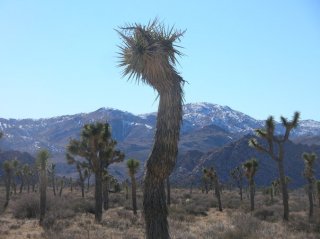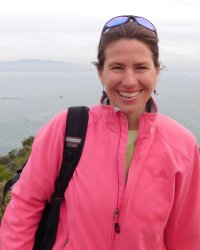Celebrating Our Environment During National Park Week
Dr. Seuss-like Joshua trees dot my ‘backyard’ in California’s Mojave Desert. They grow only in this 54,000 square-mile desert, which extends beyond California to Nevada, and into small sections of Arizona and Utah. Their twisted limbs give them a whimsical appearance. To the distant south, star-shaped sand dunes tower almost 600 feet high. Tracks of snakes, lizards, and small mammals leave clues as to what creatures live there.

Rugged mountain ranges rise up dramatically in the distance. These mountains are home to desert bighorn sheep and mountain lions. In flat areas, desert tortoises burrow where they spend 95 percent of their lives, emerging in the spring to eat wildflowers that splash the desert with color. Countless stars shine in inky night skies. There are long stretches of silence, interrupted only by sounds of nature. The desert’s immensity is overwhelming.
This was my home 13 years ago when I worked as a National Park Service ranger for eastern California’s Mojave National Preserve, and it stays with me to this day.
Protecting Public Lands & Our Environment

Special places like Mojave National Preserve exist largely because of grass roots movements from concerned citizens. Some people have dedicated their lives to fight for the environment. Rachel Carson and Minerva Hoyt were two such women. They came from different backgrounds and eras, but shared a passion for nature. Carson grew up in Springdale, Pennsylvania, in the early 1900s. She spent her childhood exploring the woods with her mom. That experience stayed with her and led to her future career as a writer and a marine biologist for what would become the U.S. and Fish and Wildlife Service. In 1962, she became well-known for her book, "Silent Spring," which exposed the dangers of DDT and other pesticides to our health and our planet. The book was instrumental in raising awareness about environmental degradation, and it helped inspire the establishment of the U.S. Environmental Protection Agency in 1970. Part of EPA’s role today is to regulate harmful pesticides.
Minerva Hoyt was a Southern belle who grew up in Mississippi during the 1860s. She left the deep South to relocate to sunny Southern California with her husband. The unexpected deaths of her husband and son devastated Minerva. Searching for solace from her grief, she moved to Joshua Tree, California. There, she became intrigued by desert plants and their unique adaptations to survive in a harsh climate. She watched in horror as Joshua trees and other plants were destroyed. Determined to do something about it, her tireless efforts led to the establishment of Joshua Tree National Monument in 1936, which later became a national park in 1994.
Spending Time Outdoors & Connecting with Nature

Like Carson and Hoyt, many of us who work for EPA have a deep connection to nature. When I was a little girl, my late mom took me on long walks in Poughkeepsie, New York, pointing out trees dressed in their fall foliage. This early love of nature led to my positions as a park ranger for NPS and now as a writer-editor for EPA. For EPA environmental scientist, Julia McCarthy, exploring the fields and wetlands near her home instilled a life-long desire to protect nature.
EPA recognizes people need to learn about nature in order to protect it. Getting outdoors is not only important for caring about the environment, but it’s also good for our health. Studies show spending time outside reduces stress and even lowers our blood pressure. However, not everyone has equal access to nature. Some families don’t have the resources to visit a national park. Some live in urban areas where there is not even a pocket park in their neighborhood. To help, we offer free resources and activities for parents and teachers to help children learn about the environment.
Working to Reduce Impacts of Climate Change
Carson, Hoyt, and others have done a lot to protect the environment, but there’s more work to be done. Habitat loss and climate change push many species to the brink and threaten our future. EPA takes actions to mitigate the impacts of climate change, which threaten species like Joshua trees. Some scientific studies predict that by 2100 Joshua trees will be extinct from the southern portion of Joshua Tree National Park, largely due to prolonged droughts and decreased precipitation driven by climate change. It’s uncertain how this could affect the yucca moth, which is the Joshua tree’s only known pollinator.
Climate change and other environmental issues can seem daunting, but I’m hopeful that people will continue working and advocating to protect our environment. I would love for everyone to experience special places like I have and find in Carson’s words that “those who dwell among the mysteries of the Earth are never alone or weary of life.”

About the Author
Hilary Clark
Writer-Editor
Region 9
Hilary Clark is a writer-editor for EPA's Pacific Southwest Region. She has also served as a community involvement coordinator doing public outreach for the clean up of Superfund sites. Before working at EPA, Hilary worked as a National Park Service ranger at various sites across the country. Her experience has made her passionate about protecting wild places and wildlife.
Editor’s Note: The views expressed here are intended to explain EPA policy. They do not change anyone’s rights or obligations. You may share this article. However, please do not change the title or the content, or remove EPA’s identity as the author. If you do make substantive changes, please do not attribute the edited title or content to EPA or the author.
EPA’s official web site is www.epa.gov. Some links on this page may redirect users from the EPA website to specific content on a non-EPA, third-party site. In doing so, EPA is directing you only to the specific content referenced at the time of publication, not to any other content that may appear on the same webpage or elsewhere on the third-party site, or be added at a later date.
EPA is providing this link for informational purposes only. EPA cannot attest to the accuracy of non-EPA information provided by any third-party sites or any other linked site. EPA does not endorse any non-government websites, companies, internet applications or any policies or information expressed therein.
